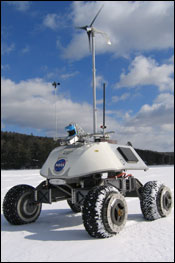 Carnegie-Mellon's sensor-laden Nomad robotic explorer, which traveled 135 kilometers across Chile's Atacama desert in 1997, is set to take on a new adventure. It's going to be sent to Antarctica to search for signs of microorganisms living in the ice -- and may be powered, in part, by an on-board wind turbine and solar panels. In preparation, Nomad took a trip across a lake in New Hampshire:
Carnegie-Mellon's sensor-laden Nomad robotic explorer, which traveled 135 kilometers across Chile's Atacama desert in 1997, is set to take on a new adventure. It's going to be sent to Antarctica to search for signs of microorganisms living in the ice -- and may be powered, in part, by an on-board wind turbine and solar panels. In preparation, Nomad took a trip across a lake in New Hampshire:
Nomad, which successfully traversed 10 kilometers through the snow and ice on Lake Mascoma, was equipped with a wind turbine for the first time, while researchers studied the possibility of powering a robotic investigation with combined wind and solar energy.Carnegie Mellon and NASA researchers worked with the Army's Cold Regions Research and Engineering Laboratory (CRREL) in Hanover, to arrange the long-distance autonomous navigation tests on Lake Mascoma, which they say simulates the flat, icy terrain of the Antarctic plateau.
A more detailed description of the Lake Mascoma excursion -- as well as some great high-res pictures of Nomad in the field -- can be found at the LORAX site (Life On ice Robotic Antarctic Explorer -- yeah, it's a stretch, but it's still a good acronym!).
This won't be Nomad's first trip to Antarctica; in 2000, it was used to search out and find meteorites in the ice, becoming the first robot to perform scientific experiments autonomously. This time around, it's been upgraded with even more sophisticated software and newly designed biosensors allowing it to seek out and identify microbes in hostile environments.
(Via Gizmodo)